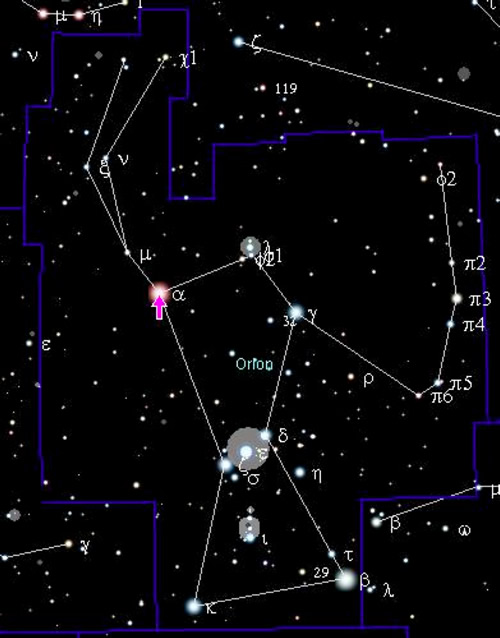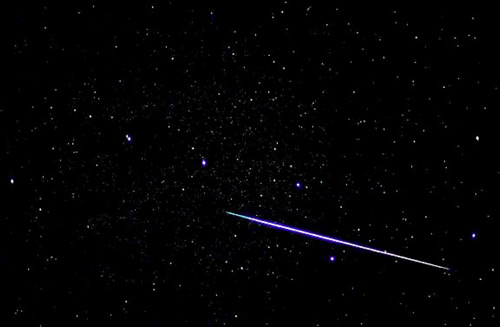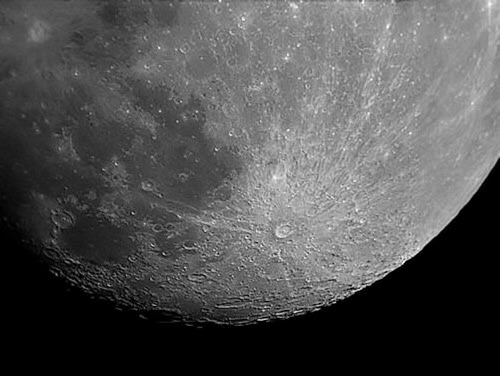
Peer at the red giant Betelguese, Geminid Meteors and Crater Tycho on the weekend of December 13 - 15, 2013.
Friday, December 13 - Today in 1920, the first stellar diameter was measured by Francis Pease with an interferometer at Mt. Wilson. His target? Betelgeuse!
Tonight let's have a look at the giant star in the northeastern corner of Orion. Rising just after skydark, Betelgeuse is winter's brighter and larger version of Antares. Like many red giants, it is inherently unstable - varying irregularly by as much as 1.3 magnitudes in cycles up to six years in length. At its brightest, Betelgeuse can appear more luminous than Rigel and its diameter could encompass all the inner planets and much of the asteroid belt. Due to low density, observers would have a hard time determining where space ended and the star began!

Betelgeuse. The pink arrow at the star on left labeled α indicates Betelgeuse in Orion.
Allowing for all ranges of radiation, Betelgeuse is more than 50,000 times brighter than our own Sun. Like Antares, it is a "star within a star" - its dense core region radiating with such ferocity that internal pressure drives matter away. Betelgeuse's core has probably fused all its hydrogen and is now releasing energy through helium fusion, resulting in atoms essential to organic life (carbon and oxygen). Even though it hasn't gone supernova yet, when it does it will outshine the Moon!
Saturday, December 14 - Despite the Moon, tonight will be one of the most hauntingly beautiful and most mysterious displays of celestial fireworks all year, the Geminid meteor shower.
First noted in 1862 by Robert P. Greg in England, and B. V. Marsh and Prof. Alex C. Twining of the United States in independent studies, the annual appearance of the Geminid stream was weak initially, producing no more than a few per hour, but it has grown in intensity during the last century and a half. By 1877 astronomers realized a new annual shower was occurring with an hourly rate of about 14. At the turn of the century, it had increased to over 20, and by the 1930s up to 70 per hour. Only eight years ago observers recorded an outstanding 110 per hour during a moonless night.

Geminid Meteors - Credit: NASA
So why are the Geminids such a mystery? Most meteor showers are historic - documented and recorded for hundred of years - and we know them as being cometary debris. When astronomers first began looking for the Geminids' parent comet, they found none. It wasn't until October 11, 1983 that Simon Green and John K. Davies, using data from NASA's Infrared Astronomical Satellite, detected an orbital object (confirmed the next night by Charles Kowal) that matched the Geminid meteoroid stream. But this was no comet, it was an asteroid.
Originally designated as 1983 TB, but later renamed 3200 Phaethon, this apparently rocky solar system member has a highly elliptical orbit that places it within 0.15 AU of the Sun about every year and half. But asteroids can't fragment like a comet - or can they? The original hypothesis was that since Phaethon's orbit passes through the asteroid belt, it may have collided with other asteroids creating rocky debris. This sounded good, but the more we studied the more we realized the meteoroid "path" occurred when Phaethon neared the Sun. So now our asteroid is behaving like a comet, yet it doesn't develop a tail.
So what exactly is this "thing?" Well, we do know that 3200 Phaethon orbits like a comet, yet has the spectral signature of an asteroid. By studying photographs of the meteor showers, scientists have determined that the meteors are denser than cometary material and not as dense as asteroid fragments. This leads us to believe that Phaethon is probably an extinct comet that has gathered a thick layer of interplanetary dust during its travels, yet retains the ice-like nucleus. Until we are able to take physical samples of this "mystery," we may never fully understand what Phaethon is, but we can fully appreciate the annual display it produces!
Thanks to the wide path of the stream, folks the world over get an opportunity to enjoy the show. The traditional peak time is tonight, as soon as the constellation of Gemini appears around mid-evening. The radiant for the shower is right around bright star Castor, but meteors can originate from many points in the sky. From around 2 am tonight until dawn (when our local sky window is aimed directly into the stream) it's possible to see about one "shooting star" every 30 seconds.
The most successful of observing nights are ones where you are comfortable, so be sure to use a reclining chair or pad the ground while looking up. Please get away from light sources when possible - it will triple the amount of meteors you see. Enjoy the incredible and mysterious Geminids!
Sunday, December 15 - Today was a very busy day in astronomy history. Tycho Brahe was born in 1546. Brahe was a Danish pre-telescopic astronomer who established the first modern observatory in 1582 and gave Kepler his first job in the field. In 1962, Mariner 2 made a flyby of Venus and became the first successful interplanetary probe. On this day in 1972, the last humans (so far) to have walked on the lunar surface returned to Earth. Eugene Cernan left the final bootprint at Taurus-Littrow and called it the "end of the beginning."

Crater Tycho - Credit: Roger Warner
Tonight it's time to a look again at the crater named for Brahe and grandest impact of all, Class I Crater Tycho. Spanning 56 miles and descending 13,800 feet below lunar surface, Tycho's massive walls are 13 miles thick. As one of the youngest craters, Tycho might not look like much tonight, but it is surely one of the most impressive of all features when the Moon reaches Full. Look around Tycho for six small craters encircling it like an old analog telephone dial. To the southeast, another prominent feature calls attention to itself - Maginus. Power up and look closely at the more than 50 meteoritic impacts that have all but destroyed it. The very largest of the wall craters is on the southwest crest and is named Maginus C. On the outer north wall, look for less conspicuous Proctor. It, too, has been struck many times!
Until next week? Ask for the Moon, but keep on reaching for the stars!
About Tammy Plotner - Tammy is a professional astronomy author, President Emeritus of Warren Rupp Observatory and retired Astronomical League Executive Secretary. She's received a vast number of astronomy achievement and observing awards, including the Great Lakes Astronomy Achievement Award, RG Wright Service Award and the first woman astronomer to achieve Comet Hunter's Gold Status.























